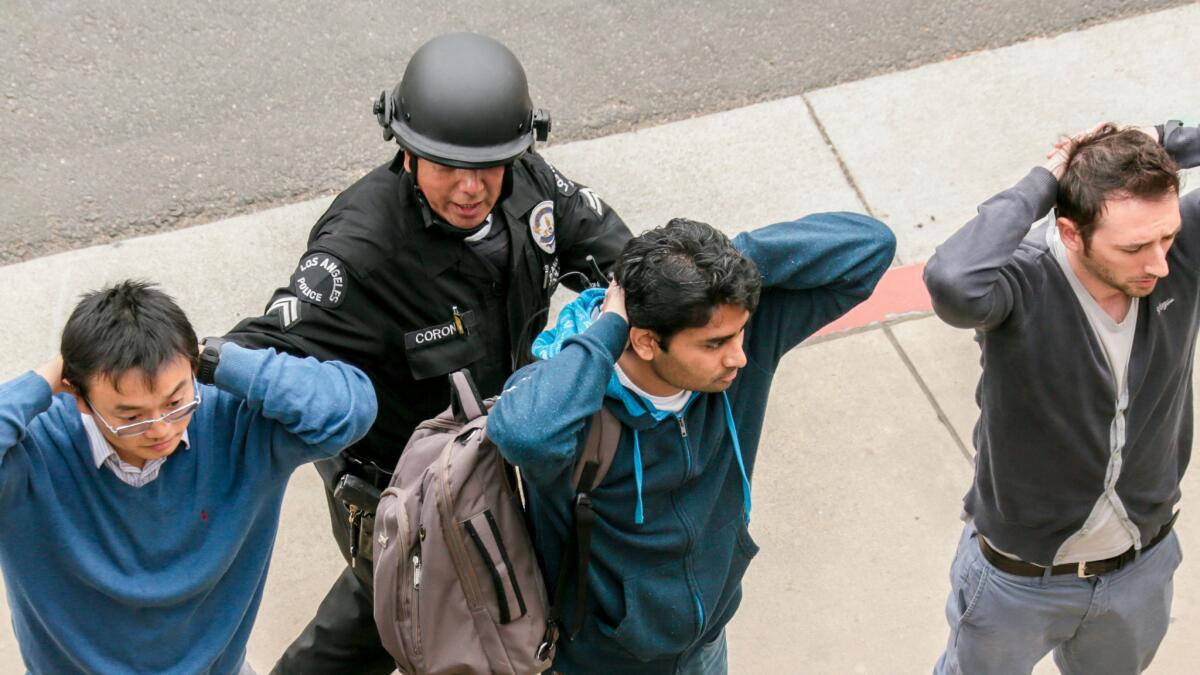UCLA says analysis of campus shooting led to security improvements

- Share via
Students and faculty saw police swarm their campus. They heard rumors of gunshots and hid in bathrooms. When they classrooms didn’t lock, they piled furniture against the doors and tried to construct makeshift barricades.
At UCLA, June 1 was a day of tragedy, fear and confusion. The campus was on lockdown until noon. Only later did the news break that a former doctoral student had stormed the office of engineering professor William Klug, 39, and shot Klug before killing himself.
School officials have analyzed the experiences of that harrowing day to try to figure out how to better handle emergencies.
On Tuesday, UCLA released a memo and a report outlining the steps it will take to improve its emergency response and attempt to prevent future crises.
The measures include better training in emergency procedures — many on campus reported not knowing exactly what a lockdown was — as well as adding locks, using faster emergency communications software, sending out more frequent alerts, and helping staff and faculty learn to detect emotional distress.
According to the report, a survey conducted after the shooting with the help of psychology professors concluded that two-thirds of staff and three-quarters of faculty respondents didn’t feel confident identifying or responding “to someone suffering from mental disturbance.”
The steps, the report said, are designed to balance security needs with the imperative that “UCLA must remain a vibrant, open, academic community.”
The task force that studied the day analyzed the timeline of how it unfolded. At 9:38 that morning, campus police got a call saying two shots had been fired in the engineering building. At 9:49, UCLA used its messaging system, Bruin Alert, to say: “Police Activity vic Engineering Building 4. Avoid area until further notice.” At 9:53, it sent another alert: “Shooting at Engineering 4. Go to secure location and deny entry (lockdown) now!” At 10:01, campus police discovered two bodies in the engineering building.
It took at least four minutes and 22 seconds for Bruin Alert emails to be delivered and five minutes and 44 seconds for people to receive Bruin Alert text messages. But some people didn’t get messages for 20 minutes.
They also had to wait for more information. Over an hour elapsed between the time the second and third messages were sent out.
Additionally, some on campus were outside the alert loop since they did not have cellphones or UCLA email addresses. The school is looking at new ways to reach such people.
UCLA has already switched messaging systems, and plans in the future to send out alerts at regular intervals, even if no new information is available. “It’s probably impossible to completely eliminate confusion, but these steps will significantly help,” said Stephen Yeazell, the task force’s chairman and an emeritus professor of law.
In doing its research, UCLA surveyed community members, and 570 responded. More than 78 percent of those who did had been on campus that day. Many said they turned to news organizations and social media to try to sort fact from fiction.
Rumors were rampant that day, and campus police fielded calls asking about shootings in seven other locations, the report said.
Some of those surveyed were critical of the school’s handling of the shooting.
“They [students] clearly didn’t know what to do,” one wrote.
“The misinformation … was extremely disturbing,” said another.
Administrative Vice Chancellor Michael Beck said verification takes time. “We can respond, ‘we haven’t identified one [shooter] yet, but it’s still important to be in lockdown,’” he said. He also spoke of the “many positive things that occurred.”
The task force looked for potential areas of improvement.
A lot of UCLA classrooms had automated locks because of fire codes and the concern that manual locks could allow a predator to lock a victim inside. Over the summer, UCLA fixed the issue for about 200 such rooms. Now their doors can be locked from inside, and administrators or law enforcement can use electronic fobs to open or close them from outside. So far, the project has cost less than $100,000, Beck said, and more classrooms likely will be updated.
Some parents praised the recommendations. “I look for loopholes...but I didn’t find anything,” said Jack Rogers, who is a psychology professor and the father of a UCLA junior.
Others thought they didn’t go far enough. Curt Hagman, a San Bernardino County Supervisor whose son goes to UCLA, called the report a “public relations piece” because it didn’t “have anything to do with law enforcement or security.” He called for more cameras and software that can track where shots have been fired.
The UCLA report made a point of stating that security measures would go only so far because “we cannot wall ourselves off from every conceivable danger.”
You can reach Joy Resmovits on Twitter @Joy_Resmovits and by email at Joy.Resmovits@LATimes.com.
More to Read
Sign up for Essential California
The most important California stories and recommendations in your inbox every morning.
You may occasionally receive promotional content from the Los Angeles Times.














